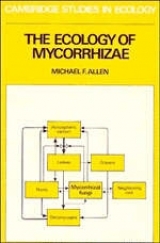
The Ecology of Mycorrhizae
Seiten
1991
Cambridge University Press (Verlag)
978-0-521-33531-7 (ISBN)
Cambridge University Press (Verlag)
978-0-521-33531-7 (ISBN)
- Titel erscheint in neuer Auflage
- Artikel merken
Zu diesem Artikel existiert eine Nachauflage
Many terrestrial plants live in close association with fungi - a mutualistic symbiosis known as "mycorrhiza". This book relates mycorrhizal biology to considerations of ecosystem dynamics, plant competition and succession.
A great many terrestrial plants live in close association with fungi. The features of this association, which is known as mycorrhiza, are those of a mutualistic symbiosis. Almost all plants from mycorrhizae whereby the fungus provides soil resources to the plant in exchange for energy provided by the plant. The symbiosis means greater productivity under stress for the plant and a steady energy supply for the fungus. This book addresses the diverse and complex ways in which mycorrhizae affect the mechanism for plant survival as individuals and populations, for community structure and functioning. An evolutionary/ecological approach is used to describe how and under what conditions mycorrhizal symbioses range from managing natural and agricultural lands to biotechnological processes that enhance agricultural productivity and sustainability. The Ecology of Mycorrhizae will be an invaluable book, applicable to all levels of theoretical and applied research in agronomy, botany, ecology, environmental microbiology, and plant pathology.
A great many terrestrial plants live in close association with fungi. The features of this association, which is known as mycorrhiza, are those of a mutualistic symbiosis. Almost all plants from mycorrhizae whereby the fungus provides soil resources to the plant in exchange for energy provided by the plant. The symbiosis means greater productivity under stress for the plant and a steady energy supply for the fungus. This book addresses the diverse and complex ways in which mycorrhizae affect the mechanism for plant survival as individuals and populations, for community structure and functioning. An evolutionary/ecological approach is used to describe how and under what conditions mycorrhizal symbioses range from managing natural and agricultural lands to biotechnological processes that enhance agricultural productivity and sustainability. The Ecology of Mycorrhizae will be an invaluable book, applicable to all levels of theoretical and applied research in agronomy, botany, ecology, environmental microbiology, and plant pathology.
List of figures; Preface; 1. Introduction; 2. Structure-functioning relationships; 3. Evolution; 4. Physiological and population biology; 5. Community ecology; 6. Ecosystem dynamics; 7. Mycorrhizae and succession; 8. Future directions for mycorrhizal research; References; Index.
| Erscheint lt. Verlag | 25.4.1991 |
|---|---|
| Reihe/Serie | Cambridge Studies in Ecology |
| Zusatzinfo | 1 Tables, unspecified; 17 Halftones, unspecified; 34 Line drawings, unspecified |
| Verlagsort | Cambridge |
| Sprache | englisch |
| Maße | 158 x 236 mm |
| Gewicht | 432 g |
| Themenwelt | Naturwissenschaften ► Biologie ► Mikrobiologie / Immunologie |
| ISBN-10 | 0-521-33531-0 / 0521335310 |
| ISBN-13 | 978-0-521-33531-7 / 9780521335317 |
| Zustand | Neuware |
| Haben Sie eine Frage zum Produkt? |
Mehr entdecken
aus dem Bereich
aus dem Bereich
Allgemeine Grundlagen und spezielle Anwendungen
Buch | Softcover (2021)
Springer Berlin (Verlag)
CHF 76,95



